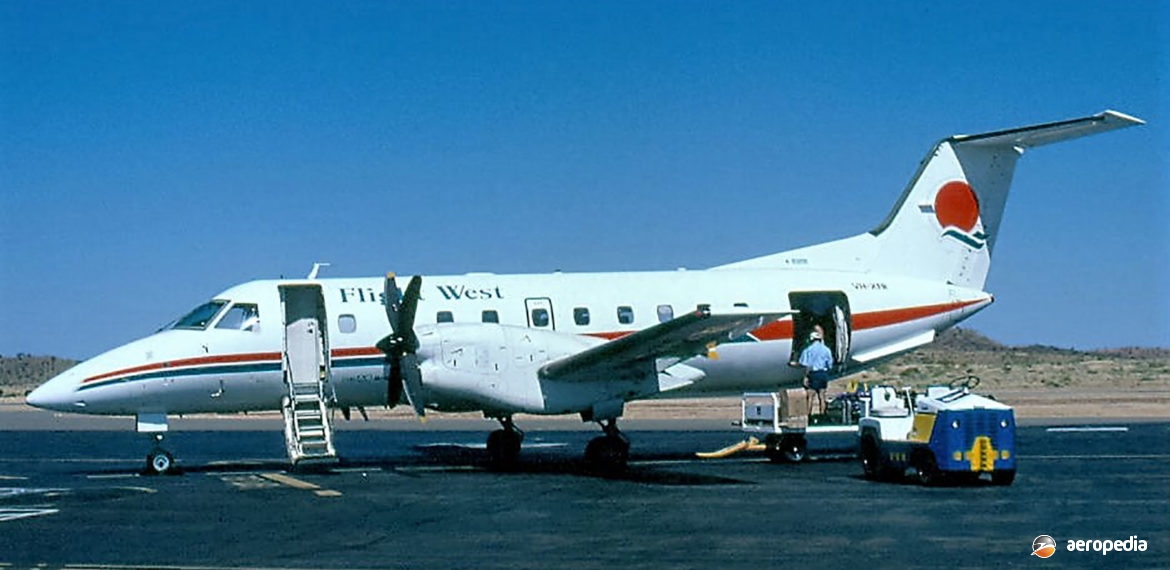Photograph:
Embraer EMB 120ER VH-XFR (c/n 120-135) at Mt Isa, QLD in September 1997 (David C Eyre)
Country of origin:
Brazil
Description:
Turboprop regional airliner
Power Plant:
Two 1,343 kw (1,800 shp) Pratt & Whitney PW-118 turboprops
Specifications:
- Wingspan: 19.78 m (64 ft 10¾ in)
- Length: 20 m (65 ft 7 in)
- Height: 6.35 m (20 ft 10 in)
- Wing area: 39.43 m² (424.42 sq ft)
- Max cruising speed at 6,705 m (22,000 ft): 556 km/h (345 mph)
- Long-range cruising speed at 7,620 m (25,000 ft): 482 km/h (299 mph)
- Max rate of climb at sea level: 646 m/min (2,120 ft/min)
- Maximum ceiling: 9,753 m (32,000 ft)
- Single-engine ceiling: 5,913 m (19,400 ft)
- Range with 30 passengers, fuel for 185 km (115 miles) diversion, and 45 mins holding at 7,620 m (25,000 ft)
- 1,750 km (1,087 miles)
- Range with max fuel, 16 passengers, same reserve: 2,982 km (1,853 miles)
- Empty weight: 7,070 kg (15,554 lb)
- Loaded weight: 11,500 kg (25,353 lb)
History:
The EMB 120 Brasilia was designed by Embraer to follow on and complement the success of the EMB 110 Bandeirante on the world’s commuter airliner market, and to provide greater capacity. However, whereas the former design had most of the market to itself, the Brasilia entered a somewhat crowded field, competing against the Saab-Fairchild SF-340 from Sweden, the slightly larger de Havilland DHC Dash-8 from Canada, the CASA CN-235 from Italy, and the ATR-42 jointly built in France and Italy.
The Brasilia was designed as the lightest, fastest, and lowest-powered aircraft in its class, and thus achieved, according to the manufacturer, the lowest operating costs, seating 30 with a crew of two. Some 350 examples were built when production ceased and switched to the very successful ERJ 135 and ERJ 145 turbofan-powered aircraft.
The EMB 120 was of conventional design with a T-Tail. It was pressurised and fitted with the new Pratt & Whitney PW-118 turboprop driving Hamilton Standard four-blade propellers. The core of this engine was the same as that used in the Pratt & Whitney PW-120 engine. The airframe structure was a mixture of chemically milled parts for areas of heavy load, with built up components for more lightly loaded areas. Kevlar and Nomex honeycomb-cored aramid composite material was used on the leading-edges of the wings, tailplane, fin, wing trailing-edges, dorsal fin, wing-fuselage fairings, elevators, ailerons, rudder and flaps. Fly-by-wire flaps were installed, each segment being driven by a hydraulic jack controlled by a computer.
The prototype (PT-ZBA) was first flown on 29 July 1983, certification being obtained late in 1984, and deliveries of production aircraft began early in 1985. A number of variants of the design were made available, these including the EMB 120RT, this having a reduced take-off weight; the EMB 120ER extended range variant; a cargo variant for carriage of freight; the EMB 120 Combi being for the mixed passenger and freight role; the EMB 120 Convertible; and variants with Pratt & Whitney PW-118A engines for hot and high areas. Last variant was the EMB 120ER Advanced, which had a range of external and interior improvements.
First of the type seen in this area PT-ZBB (c/n 120-003) made a demonstration tour in April 1985. At various times announcements were made in respect of the importation of the type, but in fact it was not until 1987 that an order was placed by Flight West for two examples with an option on two, these being imported to be operated in Queensland.
Brasilias registered with Flight West have included: VH-TLZ (c/n 120-152), VH- XFV (c/n 120-208) which later became VH-XUC with Skippers Aviation; VH- XFW (c/n 120-181), VH-XFX (c/n 120-116), VH-XFV (c/n 120-208); VH-XFQ (c/n 120-115), VH-XFR (c/n 120-135), and VH-XFZ (c/n 120-140).
In 2002 most of the Brasilias were offered for sale, a couple remaining in Australia with other operators, and a couple being exported. AirNorth Regional of Winnellie, NT aircraft have included: VH- ANB (c/n 120-116), VH-ANJ (c/n 120-163), VH-ANK (c/n 120-155), VH-ASN (c/n 120-056) and VH-DIL (c/n 120-153). Further operators have included Skippers Aviation in Western Australia with VH-XUA (c/n 120-045), VH-XUB (c/n 120-181), VH-XUC (c/n 120-208 – ex VH-XFV) and VH-XUD (c/n 120-115).
In June 2005 Pel-Air Express imported an EMB-120RT VH-EEB( ex N1117H) for freight work; National Aviation of Perth, WA operated VH-NHZ (c/n 120-034 – ex N186SW) and Regional Pacific operated two, VH-RPA (c/n 120-79 – ex DQ-MUM, N277UE) which later went to Network Aviation in 2011 as VH-TFX, and in 2014 went to AirNorth Regional as VH-ANQ; and VH-RPX (c/n 120-030 – ex P2-HLA, N271UE) which had previously operated in 1998 with HeviLift in New Guinea.

